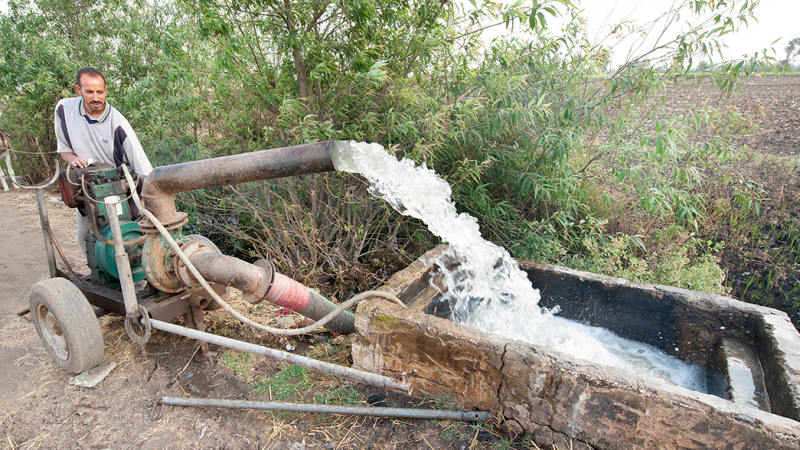Water Institutional Scarcity in MENA Region

BY AYMEN FRIJA
The impacts of climate change will be channeled primarily through the water cycle. Climate simulation models are converging in terms of forecasts for the MENA region, that already suffers scare water quantities and poor quality, with expected higher temperature and decreasing rain fall. While conventional water supply alternatives are getting more and more limited, it has been shown through many studies that water, especially for food production, is inefficiently overused in many countries of the region, and that effective investments in agricultural water demand management could generate important savings and enhance the economic value of the used water. Water demand management requires effective institutional and organizational set-up which are currently either lacking or ineffective in the MENA region.
Nevertheless, most of these countries have already been officially engaged in “the water demand management approach”. For example, more than 60% of Tunisian public expenditures in the agricultural sector is invested in water infrastructure. Moreover, many countries in the region are now diverting their investments towards water desalinization in addition to other non-conventional sources (Morocco is investing $112 Million in a desalinization plant of a total capacity of 100,000 m3/day). MENA is now capitalizing around 46% of the total desalination capacity in the world (Figure 1).
Figure 1: Desalination Capacity, by World Region, 2016 (The World Bank, 2017)
It is observed that these high cost-investments, are more preferred compared to other less costly but more complex institutional, organizational and regulatory options; which we qualify as “Trap of non-conventional water mobilization”. Therefore, policy makers in MENA region should rather stand for new revolutionary paradigms of water demand management by dealing with some of the major governance failures listed below.
National-level governance: In most of the MENA countries, failures at the national-level governance is especially related to the lack of effective coordination tools at the central level for aligning water policies with other sectoral policies. In some countries like Egypt, this coordination is difficult per-se due to the high number of public agencies dealing with water and irrigation at the central level. Dealing with this failure needs an enhanced administrative design for coordination, but also a deep and careful revision of water laws and policies to make them harmonic and compatible across relevant sectors. This horizontal coordination among different public agencies needs to become more effective in the coming years, and can benefit from the available knowledge and expertise in terms of information systems design and conception. This would also enable a flexibility in decision making for adaptive management of water resource under external shocks.
Governance functions: Failures related to governance-functions in the region are mostly due to the “widely used but weakly-enforced regulatory instruments”; the “very limited impact of economic instruments due to their poor design and implementation” (e.g. Water pricing: shortage in effective pricing mechanisms for groundwater); and to the “lack of effective voluntary & advisory policy instruments”, which are also linked to community participation instruments and collective action provision. The challenge also appears in providing a coherent and compatible set of these instruments that can effectively change stakeholders’ behavior regarding use and allocation of water. Furthermore, in MENA countries, most of the governance functions are supposed to be fulfilled by Water Users Associations (WUA) who implement and monitor water demand management tools (ex. Tunisia and Morocco). Nevertheless, WUA are not receiving sufficient technical and financial support and their regulatory framework is often inappropriate, where the state role is not clearly defined in mandated WUA areas. Therefore, this “over-reliance” of central water authorities on WUA should be revised, especially with the absence of clear indictors and operational metrics for appropriate monitoring of WUA role.
At the local level of governance, farmers, WUA, and local and regional public agencies are the main players. A mosaic of institutional problems exists at this level due to the low horizontal interactions and integration among local stakeholders, and to the dominance of some stakeholders over others. Ideally, WUA should take the lead on well-defined responsibilities, while other public stakeholders are supposed to only play minor role especially for providing incentives and training support to WUAs and to farmers but also for monitoring and control of the resource. Another major problem at this level is related to the lack of “vertical interplay” which can also be expressed as being the dynamic feedback between the local and other governance levels. Effective water governance requires the existence of appropriate stakeholders and agencies that can play this dynamic feedback role and ensure a minimum of coordination among and between local and national levels such as regional federations of WUA in Egypt.
Aymen Frija is an agricultural economist at ICARDA and based in Tunisia.
This article originally appeared in IFPRI Egypt.
